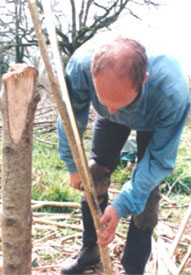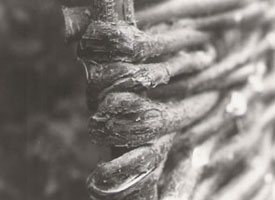|
|

|
Rods are cut before the sap rises and laid in strings for use during the summer months.
|
|
Each wride must be cut correctly leaving the mock or stool 3 or 4 inches high (note the upward cut).
|

|

|
Each rod is split through the middle by following the centre of the wood.
|
|
The rods are brought around the end sell by twisting and opening the fibres leaving a tidy twist.
|

|

|
This is how the twists should look on a well-made hurdle.
|
|
When the hurdle is complete, the ends or whips are trimmed using a specially made hook sharpened on the beak.
|

|

|

|
| The front (bark) side of a finished hurdle (note binders top and bottom) |
The back (cleft) side of a finished hurdle |
| |
• Buying Hurdles - things to look out for •
- A good hurdle needs to be square; make sure that the top is the same width as the bottom.
- It needs plenty of unbroken twists at the ends for strength.
- Likewise, the tops and bottoms should have binders (i.e a criss-cross pattern which ensures strength and durability).
- Beware if you find nails have been used; bear in mind that nails split the rods and become loose quite quickly as the wood dries.
- Traditional hurdles are made on a curve so that when they are stacked, they straighten out and tighten up - this cannot happen to a hurdle made straight and nailed.
- Check also, for the pith in the rods (this is centre of the rod), on the cleft (white) side of the hurdle. On a traditional cleft
(split) hurdle, the pith will be visible as the hurdlemaker has followed the grain of the wood thereby
maintaining it's strength.
The methods listed above have been used in England for hundreds of years and have proved the test of time. Modern mass-produced panels from Eastern Europe which are sold under
the name of wattle hurdles are not only nailed, but the rods sawn, thereby cutting the grain in many places and weakening the rods which allows the ingress of water through the cut grain which will rot the wood more quickly.
English wattle hurdle-making is completely sustainable. There is nothing involved with the production to harm the environment and once the wood has been copsed,
the re-growth begins immediately and the wood will be ready for use again in about seven years time.
|
| In the spring, after winter cutting
|

Bluebells
|

Ramsons (wild garlic)
|
|
Once cut, the copse floor becomes a mass of flowers and other flora. It is beneficial to wildlife because there are areas of hazel in
all stages of growth; some enjoying the newly cut areas, some the partly grown and more dense areas, and others the older wood which has a clear
woodland floor.
|
| Some of the flora and wildlife seen in the copse
|

Bluebells & Primroses
|

Snowdrops
|

Peacock Large White
|
|

Foxgloves in newly cut copse
|

Roe deer - a few days old
|
So, when buying hurdles, it is worth thinking of the benefits to the future of not only our
English environment but also the planet and the part you can play in it.
Few other purchases you can make can boast of such benefits.
|
© This website and its content is copyright of Steve Brown 2021. All rights reserved.

